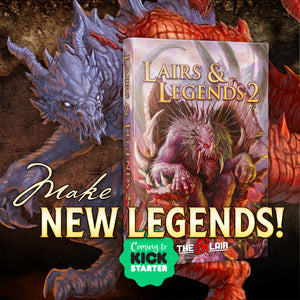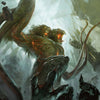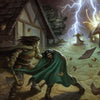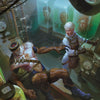10 Must-Use Feats for D&D Monsters
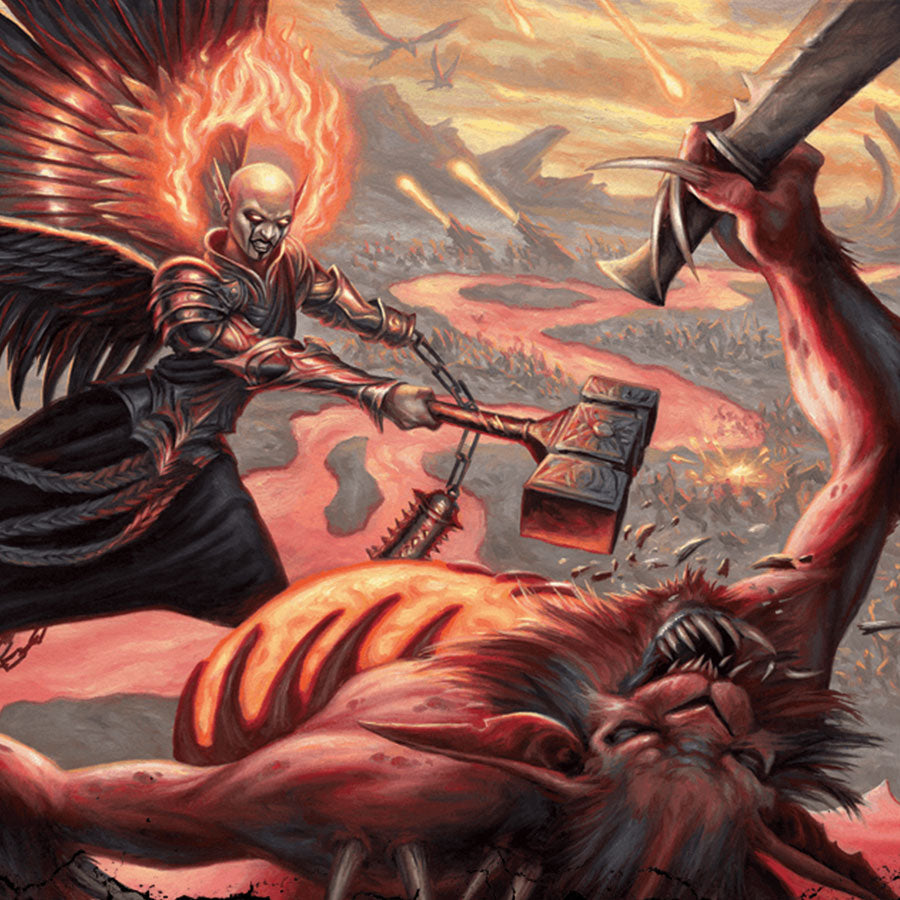
By Luke Hart
Today in the Lair, we’re talking about how to spice up your monsters—how to make them far more exciting in combat, how to keep your players on their toes, and how to help your poor creatures hold their own against player characters who just keep getting stronger with every new splat book that hits the shelves.
Let’s face it: monsters in 5e haven’t kept up. The core stat blocks were built for a game that came out over a decade ago, before Tasha’s Cauldron of Everything and every homebrew combo imaginable turned player power levels up to eleven. If you run monsters straight from the book, combat starts to feel like throwing wet noodles at demigods.
So today, we’re fixing that. We’re going to talk about why you should start giving monsters feats—and then go over ten specific feats that can transform your run-of-the-mill beasties into terrifying, tactical threats.
By the way, are you a NEW GAME MASTER feeling a bit overwhelmed by everything involved with running a role-playing game? If so, the Secret Art of Game Mastery can help. Get over 100 years of GM experience distilled into practical, easy-to-read advice.
Watch or listen to this article by clicking the video below.
Why Give Your Monsters Feats?
1. To Make Them More Interesting
Look, some monsters are just boring. Giants? By the book, they hit hard and stand there. That’s it. But give a line of Frost Giants halberds, Polearm Master, and Sentinel, and suddenly you’ve got a terrifying phalanx that locks players in place and punishes every step they take.
Feats add personality and tactics to creatures that would otherwise just swing and miss. They give you something interesting to do in combat, and they create moments your players will remember.
And honestly, it’s fun to watch the look on your players’ faces when they realize the monster they thought they knew—the one they’ve memorized from the Monster Manual—is doing something it absolutely shouldn’t be able to do.
It’s also a great way to keep cheaters on their toes. You know who I’m talking about. The players who quietly Google monster stats mid-fight to figure out resistances or HP. Give that ogre Great Weapon Master and Lucky, and suddenly their online notes are useless. Surprise!
2. To Make Them More Powerful
Let’s not sugarcoat it: 5e has power creep. Every new supplement hands out new subclasses, better spells, and stronger synergies. PCs have grown; monsters haven’t.
So as Dungeon Masters, we have two choices.
We can complain on Reddit about balance problems while our monsters get slaughtered… or we can fix it.
Feats are one of the fastest, easiest, and most thematic ways to scale monsters up without rebuilding stat blocks from scratch.
And don’t worry too much about adjusting Challenge Rating when you do this. The CR system was barely functional when it launched, and it certainly hasn’t aged gracefully. Here’s my take:
- At low levels, give a monster one feat without changing its CR. If you give it two feats, maybe bump its CR by one—but that’s optional.
- At mid-to-high levels (level 8 and up), just hand out one or two feats and call it good. No adjustments needed.
You’re not breaking balance; you’re restoring it.
The Top 10 Feats to Give Your Monsters
All right, let’s dig into the good stuff. Here are ten feats that turn regular monsters into dynamic, deadly opponents that challenge your players and make combat way more fun for everyone.
1. War Caster
Spellcasting monsters are glass cannons. They drop concentration faster than a barbarian in a library.
War Caster fixes that.
- Advantage on Concentration checks.
- Ability to cast a spell as an opportunity attack.
- No need for a free hand to handle somatic components.
Suddenly, your enemy cleric can keep spirit guardians up for more than one round, or your cult mage can cast hold person when the rogue tries to slip away.
If your players take this feat for themselves (and they do), why shouldn’t your villains?
2. Sharpshooter
Want your ranged monsters to actually feel like snipers instead of minor annoyances? Give them Sharpshooter.
It lets them:
- Ignore half and three-quarters cover.
- Shoot at long range with no disadvantage.
- Deal +10 damage per attack if they’re willing to take the accuracy hit.
This turns your archers and crossbowmen into real threats. It forces the party to think tactically—ducking behind cover, casting fog cloud, or prioritizing those archers first. It transforms the battlefield into something three-dimensional instead of a lineup of melee trades.
Suddenly, that “minor skirmish” on the ramparts becomes an actual fight for survival.
3. Lucky
Ah, the Lucky feat—the bane of DMs everywhere.
Well, now it’s your turn.
When you give this feat to a monster, you’re not being mean; you’re evening the odds. You know those critical saving throws the villain always fails? Or that crucial attack that should have landed on the wizard but didn’t? Lucky gives you a safety net.
And yes, it feels a little sleazy. It feels like cheating. But let’s be honest: your players have been doing it for years. Fair’s fair.
4. Mounted Combatant
You almost never see mounted enemies in D&D—and that’s a shame, because this feat makes mounted combat both dangerous and cinematic.
With Mounted Combatant, your monster gets:
- Advantage on melee attacks against unmounted foes.
- The ability to redirect attacks meant for their mount.
- Evasion for the mount itself.
Now you’ve got a goblin warlord on a worg tearing through the front line, or a blackguard riding a nightmare across the battlefield, slashing down PCs as the air catches fire beneath the hooves.
Mounted encounters immediately add motion, chaos, and strategy to combat.
5. Great Weapon Master
If Sharpshooter is the go-to feat for ranged attackers, Great Weapon Master is its melee counterpart.
This feat adds that iconic “+10 to damage” tradeoff and can grant an extra attack when a monster drops a foe to 0 HP. Sure, the bonus attack won’t trigger often—but the +10 absolutely will.
Give this feat to monsters with multiple attacks and high attack bonuses—ogre champions, mariliths, orcs with great axes—and suddenly your frontline fighters will start sweating.
6. Grappler
Want to add a little chaos to your melee? Enter Grappler.
- Advantage on attacks against creatures you’re grappling.
- The ability to pin them, restraining both combatants.
Picture this: the ogre brute grabs the wizard, slams them into the ground, and starts punching them into the dirt while the rest of the party scrambles to intervene.
It’s thematic, it’s terrifying, and it instantly changes the rhythm of a fight.
7. Polearm Master
This feat is already a favorite among players, and for good reason—it’s incredible.
For monsters, it means:
- An extra bonus-action attack with the opposite end of their weapon.
- Opportunity attacks when enemies enter their reach.
Even on its own, it’s a power boost. But the real fun comes when you pair it with the next feat on this list.
8. Sentinel
The Sentinel feat is pure evil—in the best way.
When a monster with Sentinel hits a PC with an opportunity attack, that PC’s speed drops to 0. Disengage doesn’t help. They’re stuck.
And if a PC attacks another creature within 5 feet of the monster, it gets a reaction attack. So basically, your monster becomes a walking lockdown unit.
Combine Sentinel with Polearm Master, and you get a phalanx of enemies that completely control the battlefield.
When my Hand of Light group descended into the Nine Hells, they faced a platoon of infernal gnolls armed with glaives. Each one had both feats, and the party found themselves locked down and bleeding before they even reached the front line. It was glorious.
9. Shield Master
This feat doesn’t just boost survivability—it changes the flow of combat.
Shield Master lets a monster:
- Use a bonus action to shove a PC prone or push them away.
- Add its shield bonus to Dexterity saving throws.
- Negate damage from area effects like fireball on a successful save.
That means the monster can control the battlefield, knock foes down for allies to attack with advantage, and shrug off the worst magical blasts your casters can throw.
You’re not just making it tougher; you’re making it smarter. Suddenly, every round becomes tactical instead of repetitive.
10. Mage Slayer
Finally, the ultimate weapon against those smug spellcasters who keep vaporizing your monsters from a safe distance.
Mage Slayer grants:
- A reaction attack when an adjacent spellcaster casts a spell.
- Disadvantage on Concentration saves for that spellcaster.
- Advantage on saving throws against spells from nearby casters.
A couple of bodyguards with this feat can absolutely ruin a wizard’s day. They keep your casters under pressure and force players to think twice before launching fireballs point-blank.
Any self-respecting Big Bad Evil Guy should have at least a few of these minions ready to counter the party’s magical nukes.
Final Thoughts
Giving monsters feats isn’t about punishing your players—it’s about making combat more fun, tactical, and memorable.
Each feat adds a layer of depth and unpredictability to your encounters. Instead of the same old “monster swings, player swings, monster dies,” you get a dynamic, living battlefield where enemies have tricks, reactions, and synergies that make your players think, adapt, and panic—in a good way.
So next time you prep a session, flip through the Player’s Handbook and ask yourself: What if this monster was built like a PC?
You might just create your most legendary encounter yet.
100 Years of GM Experience at Your Fingertips!
Are you a NEW GAME MASTER feeling a bit overwhelmed by everything involved with running a role-playing game? Are you a VETERAN GAME MASTER looking for new tips and tricks to take your games to the next level? Look no further than the Secret Art of Game Mastery.
We at the DM Lair have distilled our CENTURY of accumulated GM experience into an easy-to-read guide of practical advice that you can immediately apply to your games! We've even included our own templates–the things that we use to prepare our ACTUAL games.
Get all three books to master your game:
- The Secret Art of Game Mastery. Contains over 100 years of GM advice distilled into an easy-to-read format. It introduces and explains the tools of the trade, scheduling, playstyle, post-game notes, getting player feedback, and more.
- The Secret Art of Preparation. Brings to your fingertips the actual templates and guides that the DM Lair team uses to prepare games, Lair Magazine, and more. Designed as a three-ring binder, it's intended for you to write directly into for your entire campaign!
- The Secret Art of Notetaking. Gives you the keys to tracking your campaign from session to session just like the DM Lair team. Designed as a three-ring binder, it's intended for you to write in and keep track of your whole campaign!
With so much knowledge and experience on its pages, The Secret Art of Game Mastery is guaranteed to become an indispensable tool for all game masters, new and veteran alike. And if that isn’t enough, the information applies to all game systems and all genres!
-
Posted in
Game Master How-To Articles



